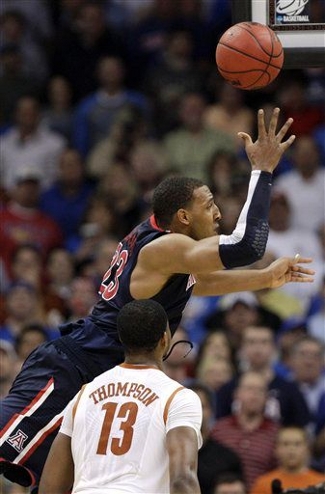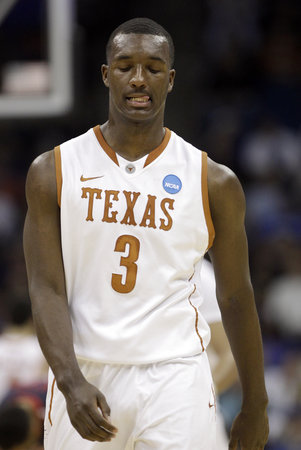[5] Arizona Wildcats (28-7) vs. [4] Texas Longhorns (28-7)
BOK Center | Tulsa, OK | Tip: 5:10 P.M. CT | TV: TNT
LRT Consecutive Game #186
The Texas Longhorns survived a scare on Friday to advance past Oakland in the second round of the NCAA tournament, but things won’t be any easier today. Their third-round match-up is a tough Arizona Wildcat team that won the Pac 10 regular-season title and lost in overtime in the championship of the post-season tournament.
A win would put the Longhorns through to the Sweet 16, a place they have been only once since 2005. In the first half of the decade, Texas was in elite company with Duke, West Virginia, and Pitt as the most frequent guests of the NCAA’s second weekend, but that now seems like a distant memory. The Longhorns will have to beat a formidable opponent this evening if they want to once again join that prestigious club.
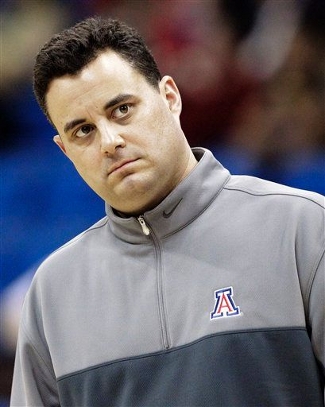
Coach Sean Miller has his sights set on the Sweet 16
(Photo credit: Charlie Riedel/Associated Press)
By the numbers
Arizona has a highly efficient offense and a sound defense. The Wildcats are aggressive with the basketball, always looking to get to the rim. Their offense has constant movement, both off the ball and with the ball. As a result, Arizona is scoring 1.154 adjusted points per possession, making them 15th-best nationally in that metric.
Every starter can drive from the perimeter, so Arizona typically sets up with four players on the perimeter and one playing the high or low post. This great floor spacing gives extra room for their slashing guards and wings to attack the paint and get layups. If the post defender helps, the Wildcats have a wide open big man waiting for the dump-off. If perimeter defense collapses down to help, the Wildcats have a bevy of three-point shooters waiting to knock down the open look.
The one drawback to Arizona’s floor spacing is that they have a hard time grabbing offensive rebounds. With most of their players far from the rim, the Wildcats are only grabbing 32.9% of their misses, a number that is just slightly above the national average. If Texas can use their size to limit Arizona to even fewer offensive boards this evening, it could seriously cripple Arizona’s offense.
The Wildcats were the best three-point shooting team in Pac 10 play, and are the 11th most-deadly team behind the arc in Division I basketball. Arizona has made 39.6% of its long-range looks, and they take nearly 37% of their shots from behind the arc. As a team, the Wildcats average nearly 20 long-range attempts per game.
Defensively, Arizona doesn’t let teams have nearly as much success from beyond the arc. The Wildcats allow opponents to shoot just 29.1% from long range, good enough for 4th place in the national rankings. Texas is actually just percentage points better, allowing a 28.7% success rate.
The weakness for Arizona is interior defense. They allow teams to make more than 50% of their shots from inside the arc, and hardly ever block shots or steal the ball. They also rarely force opponent miscues, as their defensive turnover rate is only 18.9%, ranking them 254th out of 345 D-I schools.
Meet the Wildcats
Arizona is led by sophomore Derrick Williams, an all-around athlete that was named Pac 10 Player of the Year and is one of the 30 players on the Naismith Award midseason list. (Jordan Hamilton is also part of that revered group.) Last year, he was the Pac 10’s top freshman and led the team in both scoring and rebounding.
At 6’8″, Williams is a handful to contain. He’s averaging 19.2 points and 8.2 rebounds per game, and his points come in a variety of ways. Although he only attempts about two three-pointers per game, Williams has an insane 61% success rate behind the arc.
That long-range threat helps Williams when he’s matched up with big, lumbering defensive players. He can draw them out to the perimeter and easily take them off the dribble for buckets. In an early-season game against Kansas and the Morris twins, Williams scored 27 by slashing from the perimeter and getting points in the paint.
Against smaller defenders, the Wildcats love to isolate him in the post as a part of their four-out, one-in look, and Williams will take full advantage of the situation. When stationed at the high post, he can knock down the jumper or use his great handles to shake defenders and get an easy two.
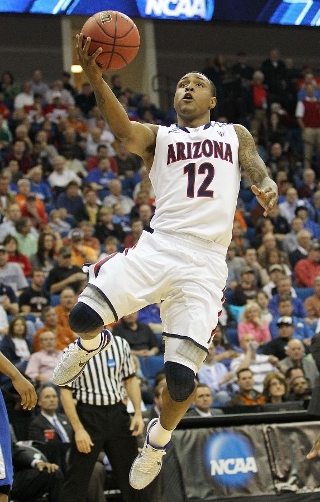
MoMo Jones is the king of acrobatic finishes inside
(Photo credit: Ronald Martinez/Getty Images)
In the backcourt, another sophomore keeps the Wildcat offense churning. Lamont “MoMo” Jones is the team’s point guard, but he’s much more scorer than simple assist man. Jones is a supremely confident, shifty guard who is second on the team with 9.8 points per game.
MoMo has a really quick release, so he doesn’t need any space to get off a shot. He’ll take a couple of rapid-fire threes in front of surprised defenders, and on the year he’s made 32.1% of his attempts. When Jones drives the lane, he’s incredibly elusive and manages to constantly finish ridiculous shots that often should be blocked.
Joining Jones in the backcourt is junior Kyle Fogg, who has been playing with a pulled quad the last two weeks. The injury limited him to just 13 minutes per game in the Pac 10 tournament, but he saw the floor for 23 minutes in the NCAA win over Memphis. The injury was just another setback for Fogg, who has had a serious run of bad luck in Tucson. Last year, he suffered a knee injury and even contracted H1N1 early in the season.
Fogg is not a guy who is going to score many points in most games, but when he does get hot — look out. Against Arizona State he made seven of 13 from beyond the arc, scoring 26 points to lead the ‘Cats to victory over their in-state rivals. He knocked down four three-pointers in four other conference games, and sunk three of them in four others. On the year, Fogg has knocked down 34.8% of his three-point attempts.
Sophomore Solomon Hill is a prototypical small forward who has started all 35 games this season, and he is averaging 7.8 points in 24.9 minutes per contest. Like most of the Wildcats, Hill is a strong 6’6″ guy who also has the ballhandling skills to slash from the wings and cause havoc inside. He’s also the team’s second-leading rebounder with 4.5 boards per game.
Junior Jesse Perry is another slashing wing for Coach Sean Miller, and he arrived in Tucson after transferring from a junior college in Saint Louis. At 6’7″, Perry gives the ‘Cats another long, athletic body that can play both inside and out, but his favorite shot is the mid-range jumper on the baseline. Like Hill, Perry provides some extra rebounding punch to help out Williams.
The sole senior on the roster is Jamelle Horne, who started 13 games for the Wildcats this season, but has settled into a role as the team’s sixth man. He is another big-time threat from long range, where he’s knocked down 40.6% of his attempts on the year. Despite playing just 18.5 minutes per game, Horne is second on the team in three-point attempts behind Fogg.
Also coming off the bench is Kevin Parrom, a 6’6″ sophomore who mirrors the rest of the Arizona roster with his ability to shoot from outside or create with the dribble-drive. He is 41.4% from behind the arc this season, but only averages 2.5 attempts per game.
Jordin Mayes is another long-range shooter on the Arizona bench, and he’s coming into this one with a hot hand. In his last three games, Mayes is 5-for-6 from behind the arc. If the Longhorns pay too much attention to Williams or overhelp on the drives from the wings, Mayes will definitely make them pay on kickouts.
While Sean Miller’s bench runs 10 deep, he has been cutting back on the minutes for Brendon Lavender and Kyryl Natyazhko in post-season play. Lavender is a catch-and-shoot guy who is averaging just seven minutes per game in the post-season.
Natyazhko is a 6’11” Ukranian who gives the ‘Cats some extra size inside, and he’s always working hard to set screens when he’s on the floor. Unfortunately, he is only averaging six minutes in four post-season games for Arizona.
Keys to the game
Just as it was against Oakland, the primary concern for Texas will be keeping Tristan Thompson and Jordan Hamilton out of foul trouble. Williams is the most-fouled player in the Pac 10, and his 88.9% free-throw rate is ninth in all of D-I basketball. He also draws nearly eight fouls per contest, so Texas will have to spread out the whistles to keep their starters in the game.
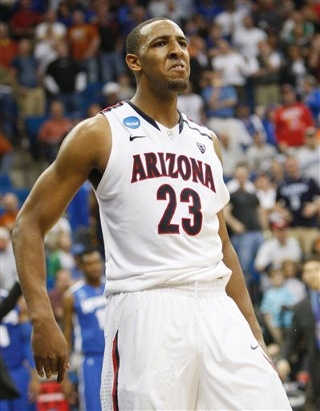
Derrick Williams will be a match-up problem for Texas
(Photo credit: Associated Press)
Defending Williams will be a challenge for Texas. Thompson cannot defend him on the perimeter and would often be beaten on Williams’ slashing attacks. Jordan Hamilton, meanwhile, is a perfect match-up in size and athleticism, but has had his share of defensive lapses this season. Gary Johnson gives up a few inches, but is athletic enough to stick with Williams on the dribble-drive. Of course, if Johnson is tasked with Williams, you can be sure Arizona will isolate him in the post.
While Arizona is a strong three-point shooting team, they have hit the skids recently. In the Pac 10 championship game, Arizona made just 33.3% of their shots from behind the arc, and ultimately lost to Washington in overtime. In their second round NCAA game against Memphis, the ‘Cats made just 26.3% from long range and struggled to knock off the Tigers. If Texas can contain Arizona’s three-point threat, the Wildcat offense becomes much less potent.
Although Texas isn’t a team that turns you over that often, the Longhorns will want to pressure the Arizona guards. This will help with the perimeter defense, and also can lead to some costly Wildcat turnovers. This young Arizona team has had seven different games with turnover rates north of 23%, so the Longhorns should be able to force mistakes. Late in games this season, the Wildcat guards have also had fits with full-court presses, particularly traps in the backcourt.
On offense, Texas needs to attack inside. We’ve already discussed the statistical gulf between Arizona’s perimeter and interior defense, but the Memphis game showed just how successful the Longhorns can be. The Tigers constantly drove baseline and found open layups or easy interior passes against the Arizona defense. For Hamilton and J’Covan Brown, that weakness on the baseline is excellent news.
Finally, Texas cannot dig a hole. The Wildcats are 26-2 this season when leading at halftime, and a big part of that is their success at the line. Arizona has made 75% of their free throws this year, while the Longhorns have stumbled to a 65% mark. If this is a close game in the final minutes, the edge would have to go to Arizona. The Longhorns need to be in control when the game comes down to the wire, or it could spell the end of their season.
| 







